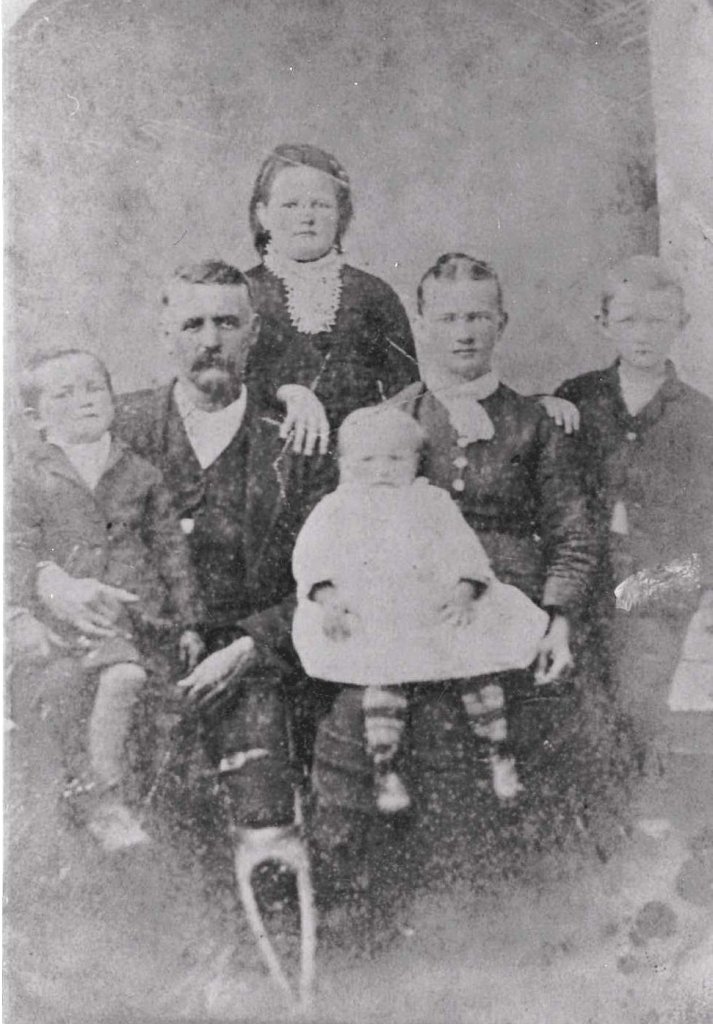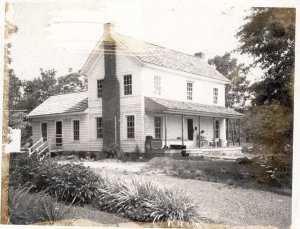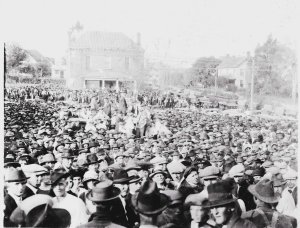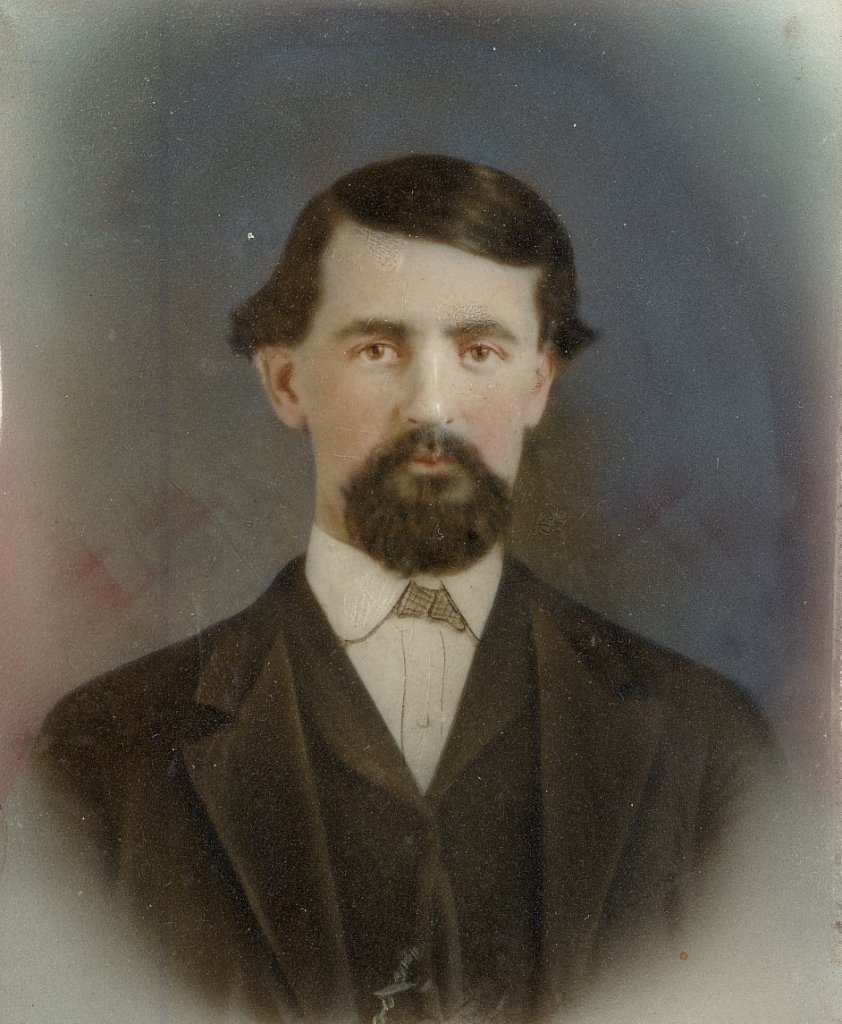A Brief History of the I.W. and Ellen Snuggs House
The Isaiah and Ellen Snuggs House is the oldest dwelling in Albemarle which still stands on its original site. The Snuggs house has been listed on the National Register of Historic Places since 1995 as #95000190, along with the Freeman-Marks House which is situated in its back lot. Its historic significance is that of Architecture/Engineering and I.W. Snuggs, himself, along with the significant areas of Politics/Government and Architecture. The periods of significance range the century from 1825-1924 (though the earliest of these years relate to the Freeman-Marks house only), and in this time the house was used domestically.
Originally a small one-story single-pen log house comprising only the first story hall and the north parlor of the present dwelling, deeds and tax records indicate the house was built in 1852 by David Austin, who purchased the lot in 1848 for $15.00. In 1859, Austin lost the property to Daniel Freeman at a sheriff’s sale for unpaid taxes. Over the next year the property changed hands twice more before it was acquired and apparently occupied by John O. Ross about 1861. Ross, a local merchant, sold the house in 1865 to Lafayette Green, a prominent attorney and a member of the House of Representatives. Green probably lived in the house while building a larger house on the southwest corner of the public square in the vicinity of what is now Starnes Jewelers.
I. W. Snuggs purchased the log house from Green in 1873 for $375. By the mid-1880s Snuggs added a second story to the home for his growing family—two girls, Bertie and Mary, and two boys, Edgar and Henry.

Snuggs family, ca. 1885. From left to right: William Henry, Isaiah Wilson, Bertha Estella, Mary Cleveland, Ellen Douglas Milton, and Edgar Eugene Snuggs.
It is believed the original front door of the log structure was closed off and a new door was centered on the hallway. A stair was installed rising eastward along the hall’s south wall to a landing, which then turns and climbs to the second story. The underside of the stair is enclosed to form a closet, inside of which is found a doorway of the original log building which opened from the hall to the outside. The south room was probably added before Snuggs purchased the house and likely dates from the 1860s. Used as a bedroom by I.W. and Ellen Snuggs, it connects to an enclosed shed ell through a doorway in the east wall, which may have been a porch before the ell was erected. After the death of his wife in 1886, it is believed the open porch at the end of the hallway was enclosed to provide quarters for a resident nanny, Sarah Boysworth—affectionately called “Aunt Sac,” who took over the care of Snuggs’ four young children. At the rear of the north log parlor is a gabled addition with a dining room and kitchen. Ghost marks on the ceiling of the kitchen indicate the presence of a cook stove flue in the northeast corner.
In 1924 the house, which was at this time owned by Snuggs’ daughter Bertha Snuggs Efird (Mrs. John S. Efird) and occupied by J. F. Morton, was moved back from the street and remodeled. A bathroom was constructed in the northeast corner of the shed bedroom and opened to the hallway. About the same time, the original front porch was replaced by a bungalow style hip roof porch with tapering wood columns on brick piers. In some rooms, the original pine floors were covered with narrow oak flooring.
In 1974, the house was renovated to serve as offices and exhibition space for the County Historic Properties Commission and Historic Museum. Successive asphalt shingle roofs as well as the original wood shingles were removed and a new roof was installed. Sheetrock was installed over the flush sheathing of the north parlor and modern mechanical and electrical systems were added. Wallpaper was added and some floors were covered with carpeting or linoleum. In 1975, the bungalow porch was pulled down and the present porch, suggested to be a replica of a circa 1874 porch, was built. Brick retaining walls and sidewalks were erected using brick reclaimed from a derelict garage which was removed from the rear of the lot. The same brick was used to lay a foundation for the porch.
In 2011, foundation concerns and extensive weather and insect damage necessitated the closure of the house to the public. In 2012, structural repairs to the foundation and the porch were completed, and the following year a new, but historically accurate roof was installed. Recently, a fireplace in the original log portion of the home was exposed, old carpeting has been removed, and sheetrock and paneling have been pulled away to reveal original wall surfaces and allow closer examination of both the original log structure and renovations done since 1874.

I.W. Snuggs House, located at 112 North Third Street. Image taken during the house’s restoration in May 1975.
Daniel Freeman House and I.W. Snuggs House
112 North Third Street, Albemarle, NC 28001
(directly behind the museum)
Isaiah Wilson Snuggs (1846-1904)
The son of Robert and Priscilla Shankle Snuggs, “Buck” Snuggs was born in the Randall’s community near what now is the town of Norwood in southeastern Stanly County. He married Ellen Milton in 1874.
Snuggs came of age during the Civil War and volunteered for service in the Confederate Army at age 17 in March 1864. Two months later he was severely wounded in the right leg at Spotsylvania Courthouse and lay on the battlefield an entire day before Federal troops realized he was still alive. He was hospitalized and his right leg amputated. Following a basic recovery Snuggs was imprisoned at Elmira, New York for the remainder of the war.
After the War, Snuggs worked with his cousin as a saddle maker and leatherworker in Albemarle. He married Ellen Milton and settled down to raise a family. Almost immediately after purchasing the cabin from Greene, Snuggs went to work improving and expanding the structure, transforming the cabin’s original core into a modern two-story home.
In time Snuggs would hold several local offices including Treasurer, Register of Deeds, and Sheriff. As sheriff, Snuggs would entertain a colorful array of politicians, community leaders, and law breakers. Snuggs’ most infamous prisoner was Alec Whitley.
Whitley was accused of theft and murder in Stanly County and also in Arkansas. Following a short manhunt through several states, he was captured by a local posse near Big Lick in 1892. Shortly after his capture and incarceration a mob of angry citizens gathered at the jail to demand Whitley be turned over to them. Snuggs had been alerted to the mob’s intention and he transferred all the prisoners from the jail to his own home across the street—except Whitley, who was seized by the mob, beaten, and hanged from a tree off South Street.

Gathering, Old Jail at the corner of Main Street and Third Street in Albemarle. The Snuggs House is at the right hand corner. (Photo is not the Whitley incident.)
In addition to his political offices, Snuggs was a capable businessman, investing in real estate, timber, and a saw mill. The saw mill was located on what is now the northeast corner of First Street and King Avenue. It is believed lumber cut and tooled at his mill was used to expand his home—this house—in the mid-1880s.

